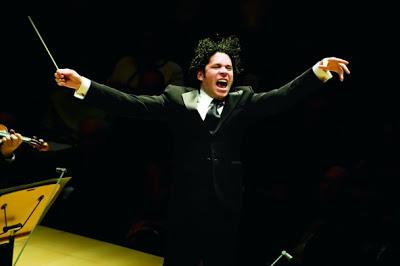
The Passion of the Dude: Gustavo Dudamel in action.
Photo © Los Angeles Philharmonic.
Mr. Dudamel is now 30, and the word "Youth" has vanished from the orchestra's posters.
Indeed, one thing that could be said for this ambitious program of Latin American classics (presented on Monday night at Carnegie Hall) is that the players, groomed in the Venezuelan government's ballyhooed El Sistema program have a tremendous sense of what it takes to play as an ensemble. And Mr. Dudamel, formerly of their ranks conducts these vast forces without a score, using an easy a command born of long familiarity and musical collaboration.
All three works on this program would challenge any orchestra. Eduardo Chávez's Sinfonía india led off, a twelve-minute work that draws inspiration from Mayan source material. Chavez was an important Mexican composer from the 1930s. His tonal language bears some similarity to the Latin-flavored works of Aaron Copland, with inventive percussion and wind writing evoking the ancient rituals of the Yucatan peninsula.
Mr. Dudamel has led Julián Orbón's Tres versiones sinfonicas at Carnegie Hall before, in a 2010 concert with the Vienna Philharmonic. Here, these rich tonal paintings, which blend the unique idiom of Afro-Cuban music with ideas that stem from medieval church music were rendered with a fine brush. Most impressive, the central Organum with its hymn-like theme over a solemn orchestral tread.
The already vast ranks of the Orchestra swelled further for the performance of La noche de los Mayas by Silvestre Revueltas. This 30-minute suite, drawn from the score of a notoriously unsuccessful 1939 Mexican film of the same title, is among the composer's most ambitious creations. It opened with a blast of bitonal brass and strings, an ear-searing chord that was unpacked to create the work's musical themes.
From there, a four-movement work that mimicked the structure of a conventional symphony followed. The most striking section of the Revueltas composition came in the tripartite final movement, as the opening chord yielded way to a vast, thunderous jam for eight percussion players using authentic instruments to create a tight, rhythmic racket. Their beats were supplanted by brass, and finally strings and the final chord returned to ca the work in a thunderous fashion.
The players met with a rapturous reception from the Carnegie crowd, complete with the unfurling of a tri-color Venezuelan flag in the parterre seats. Mr. Dudamel responded, grinning. After a few brief words with the principal string players, he led his orchestra in three encores. And although the SBSVO forces had just played a tough concert program, they sounded looser and more relaxed as they grooved on the complex rhythms.
Conga del Fuego Nuevo by Arturo Marquez opened the encores, raising the energy level with its fiery dance rhythms. The beloved Venezuelan song Alma Llanera (by Pedro Elías Gutiérrez) followed. That country's unofficial anthem had audience members singing along (encouraged by Mr. Dudamel) and a few teary-eyed. The last piece was the Mambo from Leonard Bernstein's West Side Story, a fitting tribute to the New York venue that gave the strings and horns the opportunity to get up and dance when they weren't playing.

